Val Camonica
Val Camonica (also Valcamonica or Camonica Valley, local dialect: Al Camònega) is one of the largest valleys of the central Alps, in eastern Lombardy, Italy. It extends about 90 kilometres (56 mi) from the Tonale Pass to Corna Trentapassi, in the commune of Pisogne near Lake Iseo. It has an area of about 1,335 km2 (515 sq mi)[note 1] and 118,323 inhabitants.[note 2]
| Val Camonica | |
|---|---|
| Al Camònega | |
.jpg) | |
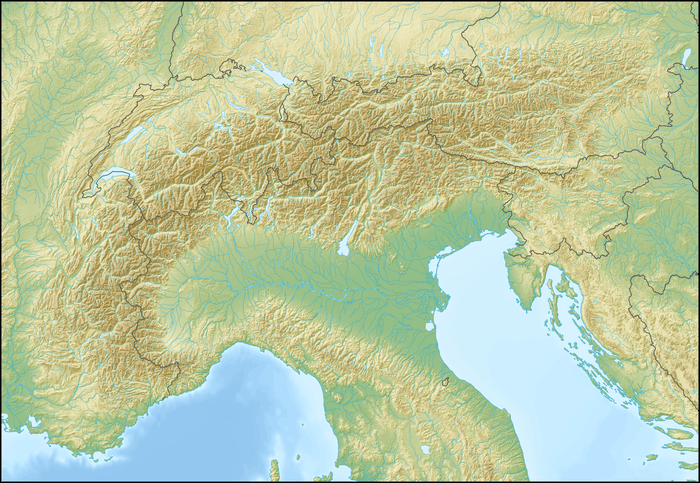 Val Camonica Location of Val Camonica within the Alps 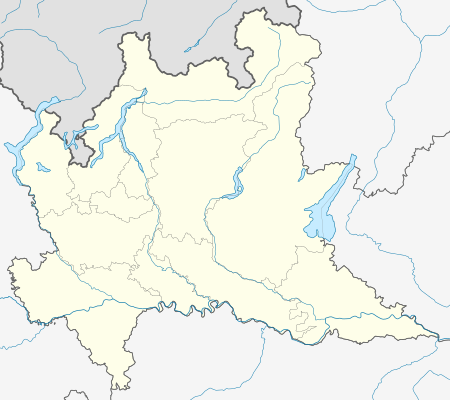 Val Camonica Val Camonica (Lombardy)  Val Camonica Val Camonica (Italy) | |
| Floor elevation | 1,883 m (6,178 ft) |
| Area | 1,335 km2 (515 sq mi) |
| Geography | |
| Coordinates | 46°00′27″N 10°20′51″E |
| Rivers | River Oglio |
| Valle Camonica - Alto Sebino Biosphere Reserve | |
|---|---|
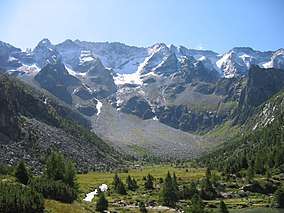 Paghera Valley and Baitone Mountains | |
| Location | Lombardy, Italy |
| Nearest city | Brescia |
| Area | 1,355.65 square kilometres (523.42 sq mi) |
| Established | 2018 |
| Governing body | Comunità Montana di Valle Camonica |
| Website | http://www.cmvallecamonica.bs.it |
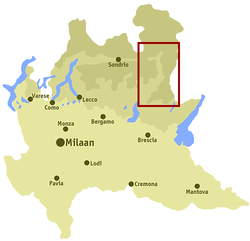
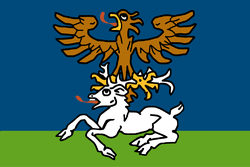
.jpg)
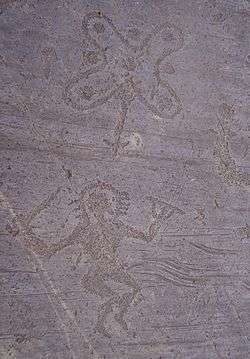
.jpg)
.jpg)
.jpg)
.jpg)
.jpg)
The River Oglio runs through its full length, rising at Ponte di Legno and flowing into Lake Iseo between Pisogne and Costa Volpino.
Almost all of the valley is included in the administrative territory of the province of Brescia, except for Lovere, Rogno, Costa Volpino and the Val di Scalve, which belong to the province of Bergamo.
Since 1979, the rock drawings located along the valley are a UNESCO World Heritage Site, while the entire valley became a UNESCO World Biosphere Reserve in 2018.[1][2]
Geography
Territory
Val Camonica can be divided into three main areas:
- Lower Val Camonica: a flat area of meadows and fields, starting from the shores of Lake Iseo and extending to the transverse ridge of Bienno, sometimes referred to as the Breno Threshold.
- Middle Val Camonica: extending from the Breno Threshold to the municipality of Sonico – Edolo. The lower middle valley extends from Breno to Sellero, while the upper middle valley starts at the narrow gorge at Cedegolo and extends to Sonico – Edolo.
- High Val Camonica: This part of the valley follows the Periadriatic Seam, and is oriented from east to west. Starting in the Val di Corteno, it continues as to the town of Ponte di Legno at the top of the valley. Its climate is similar to that of central Valtellina.
The valley is bounded by these borders:
| North | East | South | West |
|
|
|
Hydrography
Val Camonica is traversed by the River Oglio, the fifth longest river in Italy, which rises at Ponte di Legno from the confluence of the Frigidolfo and Narcanello rivers. It flows into Lake Iseo between the municipalities of Pisogne and Costa Volpino.
Numerous streams, some of them seasonal, descend from the mountainsides and flow into the Oglio.
At high altitude there are many alpine lakes, including Lago Moro, as well as many artificial reservoirs, such as the Lago d'Arno.
History
Val Camonica likely became habitable only around 15,000 years ago, at the end of last Ice Age, with the melting of the glacier that first carved out the valley. It is likely that the first humans visited the valley in epipaleolithic times, and appear to have settled by the Neolithic period. When the Ancient Romans extended their dominions north of the River Po, they encountered a people called the Camunni, of unknown origin, populating the valley. About 300,000 petroglyphs survive from this period. By the end of the first century BC, the Valle Camonica was ruled by Ancient Rome, which established the city of Cividate Camuno, with baths, an amphitheater and a large temple dedicated to Minerva.
During the Middle Ages, numerous clashes between the Guelphs and Ghibellines took place in this region. The Guelphs supported the power of the Bishop of Brescia and the papacy, while the Ghibellines sided with the Holy Roman Emperor. In 1287 the Val Camonica rebelled against control by Brescia and sided with the Visconti, lords of Milan, who extended their control over the area during the 14th century. From 1427 to 1454 there were numerous battles between Milan and the Republic of Venice for the control of the valley. Ultimately the valley came under the control of Venice. During the following centuries, the civilian population grew and engaged in the iron trade.
Val Camonica was separated from Venice after Venice was conquered by Napoleon in 1797. After the deposition of Napoleon, the area was controlled by the Austro-Hungarian Empire. In 1859, Val Camonica was annexed to the Kingdom of Italy. During World War I battle lines stretched along its eastern border, across the Adamello Group. The battles fought in this area are known as the White War in the Adamello.
In 1955, the National Park of Naquane stone carvings at Capo di Ponte was created by the Archaeological Administration of Lombardy.
Monuments and places of interest
UNESCO Site
Val Camonica is home to the greatest complex of rock drawings in Europe, containing approximately 300,000 petroglyphs[3] from the epipaleolithic era to the middle ages.
- Parco nazionale delle incisioni rupestri di Naquane in Capo di Ponte
- Parco archeologico nazionale dei massi di Cemmo
- Parco archeologico comunale di Seradina-Bedolina in Capo di Ponte
- Parco archeologico di Asinino-Anvòia in Ossimo
- Parco archeologico comunale di Luine in Darfo Boario Terme
- Parco archeologico comunale di Sellero
- Parco archeologico comunale di Sonico
- Riserva naturale Incisioni rupestri di Ceto, Cimbergo e Paspardo in Nadro
Camonica was the first site in Italy included in UNESCO’s World Heritage list in 1979 because of its unique symbols and more than 140,000 figures carved along 8,000 years on rocks.[4][5][6][7]
Medieval villages
Castles
- Castle of Breno, the largest castle in Val Camonica
- Castle of Gorzone, home of the Federici family, standing on a small hill next to the Dezzo torrent
- Castle of Cimbergo, in the valley of the Re, dominates the middle Valley
- Castle of Lozio, the fortress where the Lozio Massacre occurred
- Castle of Mù, the Federici bastion in the upper valley, of which only the foundations remain
Roman city
- Theatre and Anphitheater at Cividate Camuno
- Temple of Minerva at Breno
Mountain excursions
- CAI paths in the Parco dell'Adamello
- First World War (so-called "Guerra Bianca in Adamello") trench at Vezza d'Oglio
Roman Baths
- Boario Terme
- Angolo Terme
Museums and theme parks
- Parco tematico Archeopark, Darfo Boario Terme
- Museo etnografico del ferro, delle arti e tradizioni popolari, Bienno
- Museo Civico Camuno, Breno
- Museo didattico di arte e vita preistorica, Capo di Ponte
- Museo didattico della riserva, Nadro
- Museo archeologico di Valle Camonica, Cividate Camuno
- Mostra museo Camillo Golgi, Corteno Golgi
- Museo etnografico, Ossimo
- Museo parrocchiale d'arte sacra, Ponte di Legno
- Museo della Guerra Bianca in Adamello, Temù
Notable sanctuaries and churches
- Chiesa di Santa Maria della Neve in Pisogne
- Chiesa di Sant'Antonio in Breno
- Chiesa di Santa Maria Annunziata in Bienno
- Santuario del Cristo Re in Bienno
- Chiesa di Santa Maria Assunta in Esine
- Monastero di San Salvatore in Capo di Ponte
- Oratorio dei Disciplini in Montecchio
- Pieve di San Siro in Cemmo
- Santuario della Via Crucis in Cerveno (Sacri Monti)
Winter sports
- Winter sports Centers at Ponte di Legno, Borno, Montecampione, Aprica and Val Palot
Photo gallery
.jpg) Concarena
Concarena.jpg) Valle Adamé
Valle Adamé.jpg) Pizzo Badile Camuno
Pizzo Badile Camuno.jpg) Valle Camonica from Breno to north
Valle Camonica from Breno to north.jpg) Valle Camonica from Braone to south
Valle Camonica from Braone to south.jpg) Valle Camonica from Gorzone
Valle Camonica from Gorzone.jpg) Petroglyph from Foppe of Nadro
Petroglyph from Foppe of Nadro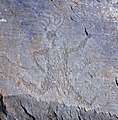 Running Priest in Capo di Ponte
Running Priest in Capo di Ponte
Notes
- Area of the municipalities, excluding Val di Scalve
- Sum of ISTAT data of communes at 31 December 2007
- The Val di Scalve is a side valley of Val Camonica, but has always been a separate entity both historically and administratively.
References
- UNESCO (26 July 2018). "Twenty-four new sites join UNESCO's World Network of Biosphere Reserves 26 July 2018". Retrieved 1 November 2019.
- UNESCO. "Valle Camonica – Alto Sebino Biosphere Reserve, Italy". Retrieved 1 November 2019.
- "Introduzione all'arte rupestre della Valcamonica su Archeocamuni.it" (in Italian). Retrieved 11 May 2009.
- Centre, UNESCO World Heritage. "Rock Drawings in Valcamonica". UNESCO World Heritage Centre. Retrieved 2019-02-13.
- "Rock Drawings in Valcamonica" (PDF).
- ""Camonica Valley Rock Art" UNESCO site n.94". www.vallecamonicaunesco.it. Retrieved 2019-02-13.
- Marretta, Alberto (2013). "The abstract mind: Valcamonica complex geometric compositions in the light of new discoveries". XXV Valcamonica Symposium 2013: 343–56.
External links
| Wikimedia Commons has media related to Val Camonica. |
